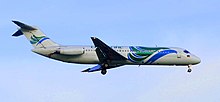avia.wikisort.org - Event
Cebu Pacific Flight 387 was a domestic Cebu Pacific flight from Ninoy Aquino International Airport in Metro Manila to Lumbia Airport in Cagayan de Oro. On February 2, 1998, the 31-year-old McDonnell Douglas DC-9-32 crashed on the slopes of Mount Sumagaya in Gingoog. The incident resulted in the deaths of all 104 passengers and crew on board.[1][2]
 A Cebu Pacific DC-9 similar to the aircraft involved in the incident. | |
| Accident | |
|---|---|
| Date | February 2, 1998 |
| Summary | Controlled flight into terrain due to Pilot error and poor crew training |
| Site | Mount Sumagaya, Philippines 08°38′56.20″N 125°01′59.60″E |
| Aircraft | |
| Aircraft type | McDonnell Douglas DC-9-32 |
| Operator | Cebu Pacific |
| Registration | RP-C1507 |
| Flight origin | Ninoy Aquino International Airport, Metro Manila, Philippines |
| Stopover | Daniel Z. Romualdez Airport, Tacloban, Philippines |
| Destination | Lumbia Airport, Cagayan de Oro, Philippines |
| Occupants | 104 |
| Passengers | 99 |
| Crew | 5 |
| Fatalities | 104 |
| Survivors | 0 |
Background

Aircraft
The aircraft involved in the accident was a McDonnell Douglas DC-9 (registration number RP-C1507) and was delivered to Air Canada in September 1967 before acquired by Cebu Pacific in March 1997.
Passengers and crew
In command of the flight was Captain Paulo Justo. His co-pilot was First Officer Erwin Golla. There were five crew members and 94 Filipino passengers, including five children. Five passengers were from Australia, Austria, Japan, Switzerland[2] and Canada. Additionally, a surgeon on a medical mission was from the United States, totaling 104 passengers.[3]
Accident
The plane left Manila at 01:00 GMT and was scheduled to arrive at 03:03 GMT in Cagayan de Oro. The plane made a stopover at Tacloban on 02:20 GMT, though sources differ about whether it was a scheduled or unscheduled stop.[3][4] According to one source, the flight made an unscheduled stop at Tacloban to deliver a needed airplane tire for another Cebu Pacific aircraft in Tacloban.[5] The last contact was 15 minutes before the plane was due to land, with the airport's ATC. In that transmission, the pilot said he was 68 kilometers (42 mi; 37 nmi) from the airport and was starting to descend. There was no indication that the plane was in trouble. The plane crashed 45 kilometers (28 mi; 24 nmi) away from the airport.[3]
Cause
The cause of the crash is still a source of controversy in the Philippines. Colonel Jacinto Ligot was the chief of the Philippine Air Force rescue team, which faced difficulties due to the deep ravines and dense vegetation on the slopes of the mountain. The pilots were flying visually, not instrumentally, when the plane vanished from radar.[2] While the skies were clear at the airport, the mountains may have been covered by fog. Chief of Staff General Clemente Mariano speculated that the plane "almost cleared the top of the mountain, but it may have suffered a down-draft, causing it to hit the mountain."[3] Jesus Dureza, the crisis manager during the rescue and retrieval operations, said he found out the Air Transportation Office maps used by the pilots listed the elevation of Mt. Sumagaya at 5,000 feet (1,500 m) above sea level, while the mountain actually is 6,000 feet (1,800 m) above sea level. This error might have misled the pilots to believe that they were clear of terrain, while in fact they were flying dangerously low. The ATO, on the other hand, pointed out in its official report deficiencies in the training of the pilots.[6]
References
- "Air disasters timeline". BBC News. 2016-12-27.
- "Weather hampers Philippine air crash search". BBC News. 1998-02-04. Retrieved 2007-04-04.
- "Passenger crash rescuers find no survivors". CNN. 1998-02-04. Retrieved 2007-04-04.[dead link]
- "Passenger plane missing in the Philippines". BBC News. 1998-02-02. Retrieved 2007-04-04.
- "Crash of a Douglas DC-9-32 on Mt Sumagaya: 104 killed". Retrieved 2022-08-22.
- "15 years after flight 387 crashed questions remain unanswered". Mindanews. 2013-02-04. Retrieved 2013-09-01.
External links
Accident description at the Aviation Safety Network
На других языках
[de] Cebu-Pacific-Flug 387
Auf dem Cebu-Pacific-Flug 387 (Flugnummer IATA: 5J387, ICAO: CEB387) wurde am 2. Februar 1998 eine Douglas DC-9-32 mit dem Luftfahrzeugkennzeichen RP-C1507 der Cebu Pacific, mit der ein Inlandslinienflug von Manila über Tacloban nach Cagayan de Oro durchgeführt werden sollte, am Berg Sumagaya ins Gelände geflogen. Bei dem Unfall starben alle 104 Personen an Bord der Maschine. Bis zum Unfall auf dem Air-Philippines-Flug 541 am 19. April 2000 war es der schwerste Unfall auf den Philippinen.- [en] Cebu Pacific Flight 387
[it] Volo Cebu Pacific 387
Il volo Cebu Pacific 387 era un volo di linea operato dalla compagnia aerea filippina low-cost Cebu Pacific fra le città di Manila e di Cagayan de Oro, che si schiantò esplodendo il 2 febbraio 1998 sulle pendici del Monte Sumagaya o del vicino Monte Lumot[1] provocando la morte di tutti i 99 passeggeri e dei 5 membri dell'equipaggio.[2][ru] Катастрофа рейса 387 Cebu Pacific
Катастрофа DC-9 под Кагаян-де-Оро — крупная авиационная катастрофа, произошедшая 2 февраля 1998 года. Авиалайнер McDonnell Douglas DC-9-32 авиакомпании Cebu Pacific совершал внутренний рейс 5J387 по маршруту Манила—Таклобан—Кагаян-де-Оро, но при заходе на посадку в пункте назначения врезался в гору Сумагайя. Погибли все находившиеся на его борту 104 человека — 99 пассажиров и 5 членов экипажа[1].Другой контент может иметь иную лицензию. Перед использованием материалов сайта WikiSort.org внимательно изучите правила лицензирования конкретных элементов наполнения сайта.
WikiSort.org - проект по пересортировке и дополнению контента Википедии